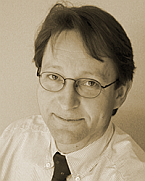Invited Speakers
sorted alphabetically ...
 Wilhelm Burger Upper Austria University of Applied Sciences, Austria |
Computer Vision - Mission Accomplished or Punk? [Slides]This talk tries to review the current state of Computer Vision from a mostly non-technical perspective.Striking success in some highly visible application areas has shifted Computer Vision into the focus of modern industrial developments in recent years. While such breakthroughs caught broad attention and well- deserved interest, the fact that this is the harvest of decades of intensive research in academia and industry, advanced concepts and a long evolutionary process is often overlooked by the public. It obscures the real situation as that we have only reached a solid starting point, that many difficult problems remain to be solved and development will continue to take time, financial and human resources, perhaps even more than has been invested so far. In other words, computer vision is not a simple, out-of-the-box technology yet, being neither easy nor universally applicable. On the other hand, we observe a spreading misconception among decision makers in industry, politics and media that AI technology (and computer vision in particular) has matured to a point that, from now on, practically any smart and/or human-like task can be solved with ease. Moreover, newcomers like Google are trusted (and feared) by the public opinion to have a salvation message and solution to problems of arbitrary complexity. While this may be a bit reminiscent of the 'steam punk' era, it bears the dangers of misguiding long-term decisions relevant to industrial strategy, research funding and education. It also raises the question about our own responsibilities as researchers and educators and what we can do (or rather not do) to communicate an appropriate and realistic picture of this field in the public. |
 Mario Vento University of Salerno, Italy |
Are we ready to use graphs in Pattern Recognition? [Slides]Graphs are used in Pattern Recognition for representing objects of interest by means of parts suitably connected with each other.This kind of representation induces the need to formulate the main operations required in Pattern Recognition in terms of operations on graphs: classification, in terms of comparison between an object and a set of prototypes, and learning, which is the process for obtaining a model of a class starting from a set of known samples. The advantage of using graphs over statistical approaches is related to the contextual use of information about the single parts of an object during the classification procedure; the matching is in fact carried out parts by parts and not in the whole and this property allows it to attribute at any single part the relevance it assumes in the specific comparison. Forty years have passed since the first papers on this topic appeared in the literature. A lot of research effort has been devoted to explore this challenging field and some approaches have been meanwhile consolidated. The talk is organized as an introduction to the most relevant techniques proposed over these years, so as to give the audience an overview of the field. The presentation is aimed at revealing the rationale inspiring the papers published in these years, which is used as the basis for a coarse classification of the techniques. Particular attention is devoted to recent advances in exact graph matching algorithms, that are opening new scenarios in different fields requiring the matching of huge graphs, up to thousands of nodes. |
 Ivan Viola TU Wien, Austria |
Multi-Scale Molecular Data Visualization [Slides] [PowerPoint1GB]The study of biological processes carried out in living organisms is among the central foci of modernscience. The field is nowadays by large extent computational, there are many kinds of digital models that characterize particular aspects of life. To provide a comprehensive view on biological phenomena, visualiza- tion offers itself for integrating multiple models into one visual environment. One of the interesting chal- lenges, associated with such a visual integration, is to communicate phenomena that are simultaneously de- scribed on several spatial and temporal scales. In my talk we will discuss a variety of visualization tech- niques that bridge several orders of magnitude of spatial scale by interactively rendering structural infor- mation from a single atom level (10-10 m) up to the scale of entire viruses or bacteria with a complete molec- ular machinery (ca. 10-6 m). Integrative structural biology models are very dense and consist of many struc- tures each of these serving a particular function. In order to convey such information clearly, I will discuss how visual abstractions help us to visualize multiple scales and how these techniques can be used to deal with the structural occlusion inherent in the integrative model. To convey a living structure, large structural mod- els can be extended with dynamic biological models of physiology. In the last part of my talk I will discuss an integration of molecular reaction pathways with the structure. The reactions are modeled quantitatively, can be executed in run-time during interactive visualization to allow for interactive visual steering of the simulation parameters.
|
